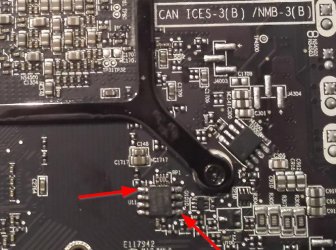RogerK88
New Member
- Joined
- Jul 14, 2021
- Messages
- 21 (0.01/day)
Hi guys,
Yesterday I tried to flash the bios on my MSI RX580 Gaming X 8gb, but I came into a problem where amdvbflash.exe (command prompt) complained the the rom was "unsigned", and came back with a fail error. I can't remember what that error is now.
For whatever reason, the system became unstable, and appeared to be locked up. Mouse not move, numlock unresponsive, etc.
I decided to do a hard boot, and when the system came back, the card was gone from Windows device manager. I figured the flash must have gone bad, so I tried all the following:
- re-flashing in windows with all other GPUs out.. Both Win and CLI versions of AMDvbFlash: Result: device not found which was to be expected to be honest.
- enabled the mobo onboard graphics, removed all GPUs except the MSI RX580, booted back in via freedos and tried flashing with the DOS version of AMDflash, same result: Device not found.
- tried the above on a second motherboard with the same results as above.
The commands I used were: amdvbflash -f -p 0 <bios.rom>
I see on the interwebs that shorting 2 pins on the bios chip can bring the card back once it gets past post. But I am assuming this is only on the 2 bios models?
Unless there are any other suggestions, it looks like I might need to buy one of those programmers that clip directly to the bios to flash it directly. I did save my original rom, so if that were to be successful, I can bring my card back to life.
If I have to go that route, can anybody point me to where the physical bios chip is on the card?
Any help on this would be great. I have been kicking my own ass for the last 14 hours. I have flashed bios' many times, and can't help but think I should have waited longer before doing that hard boot.
Edit: I just read this epic thread from front to end:

 www.techpowerup.com
www.techpowerup.com
However if there is anything you think I might have missed in my steps above, please let me know.
Cheers guys....
Yesterday I tried to flash the bios on my MSI RX580 Gaming X 8gb, but I came into a problem where amdvbflash.exe (command prompt) complained the the rom was "unsigned", and came back with a fail error. I can't remember what that error is now.
For whatever reason, the system became unstable, and appeared to be locked up. Mouse not move, numlock unresponsive, etc.
I decided to do a hard boot, and when the system came back, the card was gone from Windows device manager. I figured the flash must have gone bad, so I tried all the following:
- re-flashing in windows with all other GPUs out.. Both Win and CLI versions of AMDvbFlash: Result: device not found which was to be expected to be honest.
- enabled the mobo onboard graphics, removed all GPUs except the MSI RX580, booted back in via freedos and tried flashing with the DOS version of AMDflash, same result: Device not found.
- tried the above on a second motherboard with the same results as above.
The commands I used were: amdvbflash -f -p 0 <bios.rom>
I see on the interwebs that shorting 2 pins on the bios chip can bring the card back once it gets past post. But I am assuming this is only on the 2 bios models?
Unless there are any other suggestions, it looks like I might need to buy one of those programmers that clip directly to the bios to flash it directly. I did save my original rom, so if that were to be successful, I can bring my card back to life.
If I have to go that route, can anybody point me to where the physical bios chip is on the card?
Any help on this would be great. I have been kicking my own ass for the last 14 hours. I have flashed bios' many times, and can't help but think I should have waited longer before doing that hard boot.
Edit: I just read this epic thread from front to end:

How to recover from a bad video BIOS flash
I'm in a similar situation but on an RTX - any chance there's a version of nvflash that supports both -5 and -6 AND RTX cards? None that I know of. Just with SPI programmer.
However if there is anything you think I might have missed in my steps above, please let me know.
Cheers guys....
Last edited:





